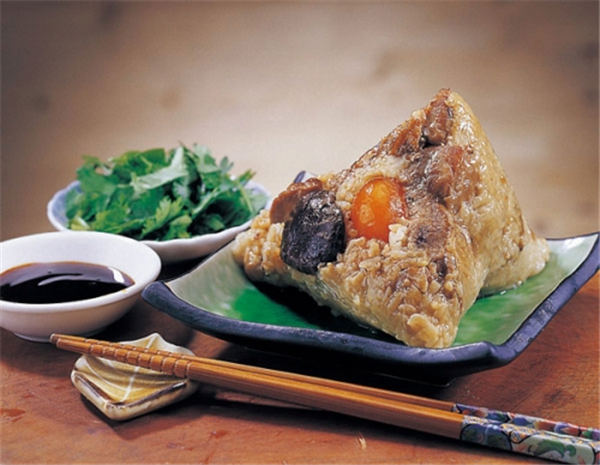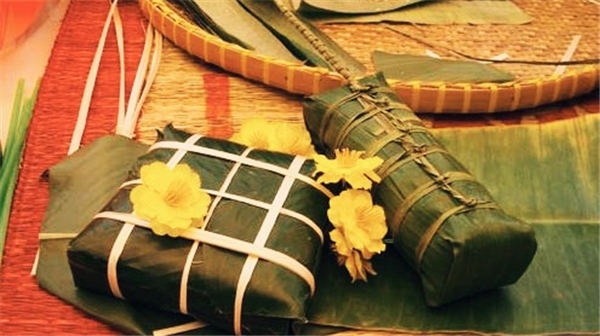

The most romantic – Hangzhou zongzi

Hangzhou couple zongzi. [Photo/CGTN]
In Tangxi ancient town in Hangzhou, East China's Zhejiang province, zongzi even has "gender," divided into "males" in the more common shape of a pyramid and "females" in a quadrangular pyramid. The latter is also nicknamed the "axe zong."
Aside from the shape, what's inside is another clue to the zongzi's gender. Male zongzi are usually stuffed with nothing or shredded lotus root whereas female ones are filled with red beans or meat. People in Tangxi town recall that zongzi actually served as gifts sent mutually that symbolize the beginning of a formal relationship among couples.
Boys with pyramid-shaped zongzi and girls with axe zong attended a party for blind dates, where the boy would give his zongzi to the one he falls in love with, and if he receives the girl's zongzi in return, a love story would blossom.
The most global – Hokkien zongzi

Hokkien braised pork zongzi. [Photo/xinhuanet.com]
With Hokkien migrants across the world, Hokkien braised pork zongzi (also known as bakchang or machang originating from the Hokkien dialect), embracing fame at home and abroad, is very likely to be the most global one.
Braised pork zongzi is one of the most typical specialties in southeast Fujian province in East China, which is popular in Taiwan, as well as in Southeast Asian countries like Singapore, Malaysia and Indonesia.
The inside of the zongzi containing well-braised pork and extra fillings of mushrooms, dried shrimp or oyster and lotus seeds is the selling point. Wrapped with reed leaves and trussed with twine, the Hokkien version of zongzi has rich flavors thanks to the sticky rice, moist but not mushy, seasoned perfectly with broth after being steamed.
International versions of zongzi

Vietnamese rounded and square zongzi. [Photo/china.org.cn]
Spread through the Chinese diaspora, zongzi today involves many variations in different countries around the world.
In the shape of a thin elongated cone, Japanese zongzi, called "chimaki" and mostly eaten during Children's Day on May 5, uses mashed rice flour instead of glutinous rice and stuffed with various kinds of fillings like fruit, egg yolk or small fish fillet.
The Vietnamese make two shapes of zongzi, rounded ones (referring to the heaven) and square ones (referring to the earth), which contain unique fillings mixed with pepper, mung beans and pork wrapped with banana leaves. Eaten on the same day as Chinese Dragon Boat Festival, the rounded and square zongzi are a symbol of good fortune and the bumper harvest.
Singaporeans love flowers, thus they immerse zongzi in flower juice and offer it as a treat for guests. The rice flour becomes green after absorbing the juice and glitters and looks translucent.
As a specialty of Peranakan cuisine, Malaysian zongzi (Nyonya chang) are made of regular glutinous rice and blue rice immersed in blue flower juice typically stuffed with mixed spices, pork mince, winter melon and roasted peanuts. The authentic Nyonya chang ought to be steamed or boiled with coconut milk.
Mexicans also have their own version passed down through history in the region called "tamale," made of corn flour or dough with the fillings of meat cubes, chilies, cheese and any ingredients according to personal palates. Wrapped and steamed in banana leaves or corn husks, tamales full of flavor are quite a meal on their own.
 |

 Award-winning photos show poverty reduction achievements in NE China's Jilin province
Award-winning photos show poverty reduction achievements in NE China's Jilin province People dance to greet advent of New Year in Ameiqituo Town, Guizhou
People dance to greet advent of New Year in Ameiqituo Town, Guizhou Fire brigade in Shanghai holds group wedding
Fire brigade in Shanghai holds group wedding Tourists enjoy ice sculptures in Datan Town, north China
Tourists enjoy ice sculptures in Datan Town, north China Sunset scenery of Dayan Pagoda in Xi'an
Sunset scenery of Dayan Pagoda in Xi'an Tourists have fun at scenic spot in Nanlong Town, NW China
Tourists have fun at scenic spot in Nanlong Town, NW China Harbin attracts tourists by making best use of ice in winter
Harbin attracts tourists by making best use of ice in winter In pics: FIS Alpine Ski Women's World Cup Slalom
In pics: FIS Alpine Ski Women's World Cup Slalom Black-necked cranes rest at reservoir in Lhunzhub County, Lhasa
Black-necked cranes rest at reservoir in Lhunzhub County, Lhasa China's FAST telescope will be available to foreign scientists in April
China's FAST telescope will be available to foreign scientists in April